 Photo Credit: Getty Images
Photo Credit: Getty Images
By: Crae Messer | Follow Me On Twitter @Crae_Messer
We all remember that moment so vividly. Round 1. Game 7. The opponent? The Toronto Maple Leafs.
The clock ticked toward the 14:30 mark of the third period and B’s forward Jake DeBrusk gathered a pass from teammate David Krejci along the right-hand side of his team’s blue line with a full head of steam. He looked up to see Leafs defenseman Jake Gardiner in his face and shifted the puck to his backhand.
He entered the Toronto zone with virtually no angle to the goal on his off-wing, but that wasn’t about to stop him. He set the edge at about the face-off dot to Frederik Andersen’s glove-side, shifted the puck back to his forehand, and, well, you know the rest.
DeBrusk’s heroic effort was the difference-maker in a historic win for a Bruins team that most people never expected to be in the playoffs, let alone winning a series against Auston Matthews and company. And while DeBrusk’s second goal of the evening was undoubtedly one of the top highlights of the game, if not the season, what came immediately following gave us a sense of the type of player the B’s drafted with the 14th overall pick in 2015.
Following his typical emotion-filled celebration, DeBrusk led his linemates toward the Bruins’ bench. He grabbed the spoked-B on his chest and waved it like a flag – one he couldn’t be more proud to be wearing. If his two-goal performance in a Game 7 doesn’t get you excited for what’s to come, then that act of passion that followed most certainly should. But what does the Edmonton native’s future look like donning the black and gold? Let’s take a look at his first year in Boston.
DeBrusk’s First Go-Around
I sat in the stands for the B’s season-opener, when they came out of the gates firing on all cylinders to top Nashville, 4-3. It didn’t take long for the Bruins to find their groove, and the same went for DeBrusk. He scored his first of 16 regular season tallies. That first goal, by the way, was a backhand-to-forehand finish, much like his memorable Game 7 goal.
That’s also when we saw the first of his passionate goal celebrations. When that kid lights the lamp, his fervent celebrations light up the crowd in a way us modern NHL fans aren’t seeing much these days. That’s another discussion altogether.
In his first year in the big-leagues, DeBrusk, for the most part, lived up to his scouting report. He was labeled a big, goal-scoring winger, who wasn’t afraid to mix a bit of physicality into his game. Experts compared him to Columbus Blue Jackets forward Nick Foligno. Foligno entered the NHL in the 2007-2008 season and played 45 games. His first full season in the show came a year later when he put up 17 goals and 15 assists. Foligno and DeBrusk both stand in at 6 feet even, while Foligno has the edge in weight, listed on NHL.com at 202 pounds. DeBrusk is nine years younger than the seasoned vet Foligno, so he’s likely to put on weight over time, but is currently listed at 188 pounds.
This season, DeBrusk scored in back-to-back games three times. He registered nine multi-point games. He had just one multi-goal game, a 5-1 win over the Panthers on March 31 in which he added an assist. His longest goal-drought was an 11 game stretch from January 30 to February 20. He went six games without a point from October 15 to October 30. Aside from that, the youngster who secured a spot in the B’s lineup produced on a relatively consistent basis.
Looking Familiar
Strictly speaking in my personal opinion, DeBrusk reminds me, in some ways, of a former Bruin. One that departed not that long ago, and one that left an unforgettable impression on B’s fans on his way to helping the black and gold win their first Stanley Cup in 39 years. With a bit more skill and speed, and a bit less physicality, DeBrusk shows shades of Milan Lucic.
I know what many of you are probably thinking, and it’s that I’m wrong. But take a look at that kid’s aggression and passion out there. He gives his all when he’s on the ice. He’s not afraid to take a hit to make a play (refer to memorable Game 7 goal). He’s a fairly big kid with plenty of room to grow, and in time, could fill out to be a more skilled version of Lucic. Or, I could be dead wrong.
Looking at players that similar offensive production to that of DeBrusk this season provides an interesting perspective. One other player in the NHL put up the same offensive numbers as DeBrusk this season with 16 goals and 27 assists: Bryan Little. The Winnipeg center, coincidentally, measures in at 6-feet and 191 pounds.
Patrick Maroon, who split the year in Edmonton and New Jersey, posted 17 goals and 27 assists. Maroon’s a bit bigger than DeBrusk, but the points are similar. The main difference between DeBrusk and guys like Little and Maroon, who all posted similar offensive numbers, is that the latter two players are much farther along in their careers.
To get a potentially better idea of DeBrusk’s future production, a look at some of today’s veterans, and their offensive performances in the early stages of their career is important.
What’s Ahead?
Now, it’s key to state that these comparisons are in no way guarantees of the future. They’re simply an analysis of statistics put up by NHL players, and what it could mean for the future of Jake DeBrusk.
Claude Giroux – Philadelphia Flyers
 Photo credit: Tom Mihalek/AP
Photo credit: Tom Mihalek/AP
This year, in his 11th season, the Flyers captain potted 34 goals with 68 helpers that landed him second in the points race with 102.
Giroux was eased into NHL play a bit more than DeBrusk was. He played just two games in 2007-2008. The next season, he scored nine goals with 18 assists in 42 games. It wasn’t until the 2009-2010 season that Giroux played a full year. His production back then looks familiar, scoring 16 goals with 31 assists.
Giroux comes in at 5-foot-11 and 188 pounds, so he’s a tad smaller than DeBrusk. But he’s physical with a great deal of strength, and he’s not easily knocked off the puck. He’s a more natural-scorer than DeBrusk at this point in the Bruins’ winger’s career, but again, he’s young. At just 21, DeBrusk has plenty of time to improve his shot and his stickhandling abilities. Even one offseason can make a difference.
Blake Wheeler – Winnipeg Jets
 Photo credit: Bruce Fedyck/USA Today Sports
Photo credit: Bruce Fedyck/USA Today Sports
A familiar name, Blake Wheeler started his career in the NHL (and the Bruins) with very similar production to that of Jake DeBrusk in his first season.
Wheeler was drafted in 2004 by the Phoenix Coyotes. After playing a few more seasons of college puck, he opted out of his deal with Arizona and elected to sign with the Bruins. In 2008-2009, the right-hander buried 21 goals and 24 helpers in 81 games. The next year, he scored 18 times, adding 24 assists.
Wheeler then experienced a pair of down years, one in Boston and one in Atlanta, before finding his offensive rhythm once and for all in 2012. He hasn’t scored less than 40 points since then, including his 91 points (23 goals with 68 assists) this season.
While he’s a right-handed shot, and quite a bit bigger than DeBrusk, I believe the B’s new winger has the potential to improve to the point where he’s able to make space for himself the way Wheeler does. If so, that’s countless more scoring opportunities, which leads to more offensive production.
Jakub Voracek – Philadelphia Flyers
 Photo credit: Getty Images
Photo credit: Getty Images
If you don’t see shades of Voracek in DeBrusk’s game, then you might not be watching closely enough.
The left-shot right winger made his NHL debut in the 2008-2009 season and went on to play in 80 games with the Columbus Blue Jackets that year. He scored nine times with 29 assists that year.
His next few years looked like this:
 Photo courtesy of NHL.com
Photo courtesy of NHL.com
It wasn’t until the 2013-2014 season that Voracek started putting up top-notch numbers. This past season, the power forward scored 20 goals, adding 65 assists. DeBrusk tallied more points in his rookie season that Voracek did, but if the Bruins winger can produce in his second season, at the rate that Voracek did in his, then we’re in for a treat next year.
Aside from his scoring and playmaking abilities, Voracek brings something to the ice that you can’t teach: His presence. He’s a player that opposing teams take note of when he’s on the ice. There’s no doubt that Bruins management and coaching staff hopes for DeBrusk to have that same effect in the near future, but until then, it will be exciting to watch him grow.
Like I mentioned before, this in no way is a 100-percent guarantee that DeBrusk will eventually find himself in the top tier of NHL scorers. But there’s a pattern here. Take a look at the similarities between the way these guys play the game. DeBrusk fits the theme, and there’s a good chance he could find his way onto the Bruins’ top line in years to come.


Leave a Reply